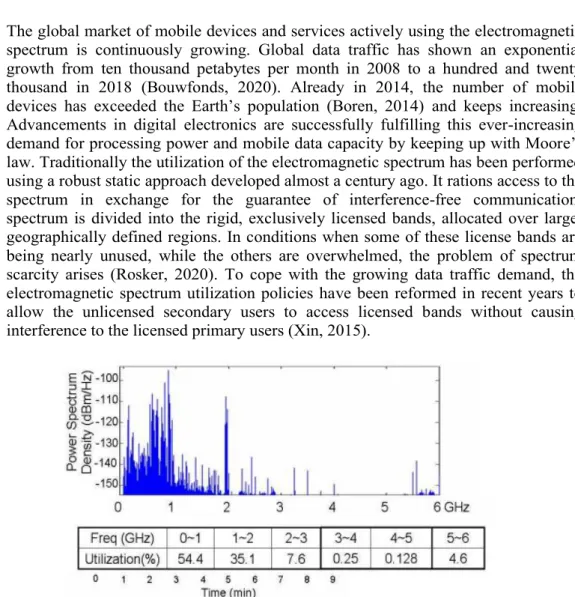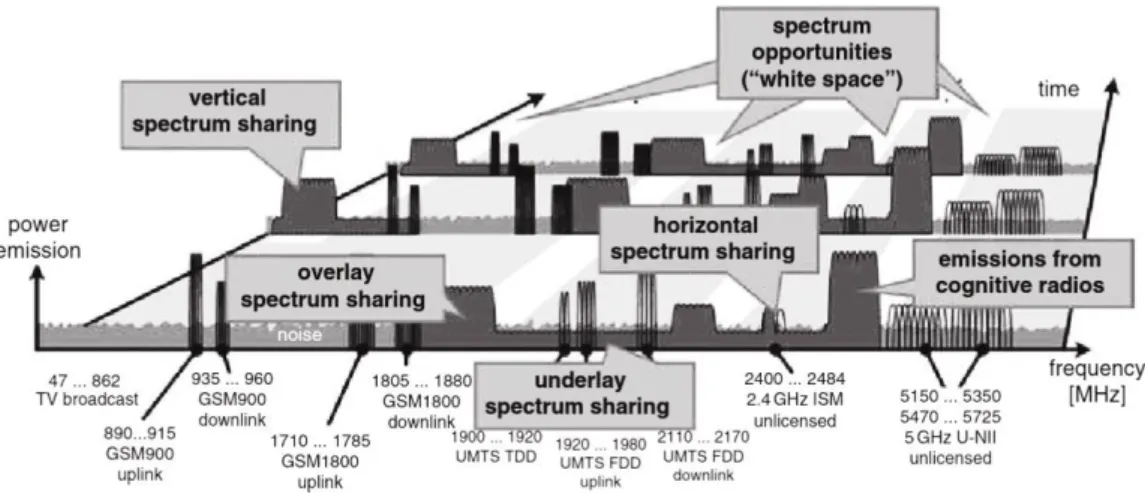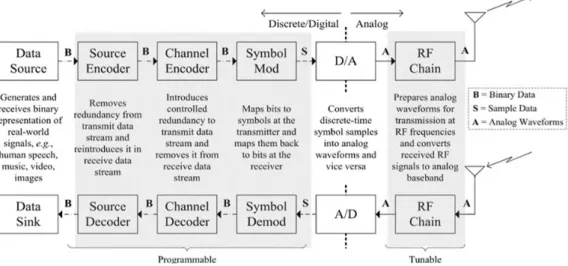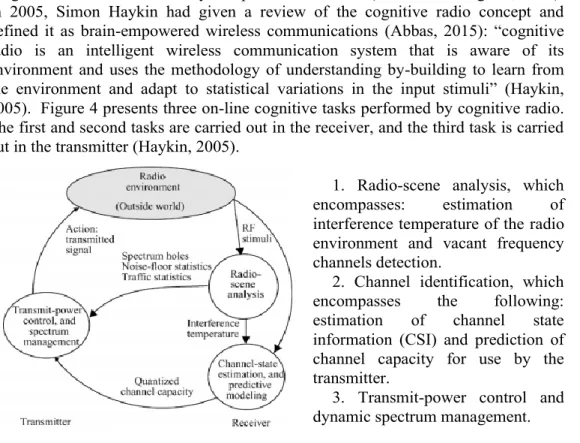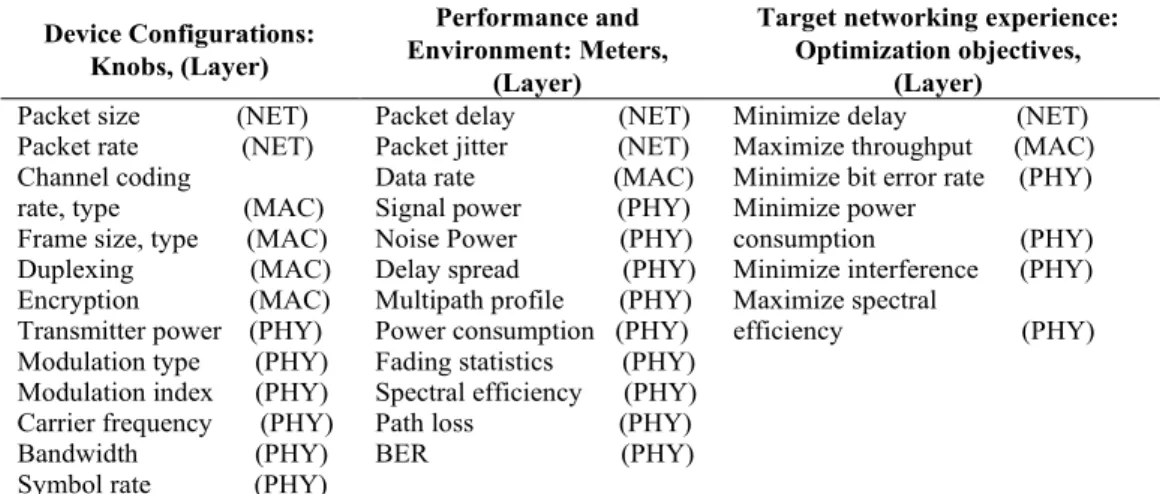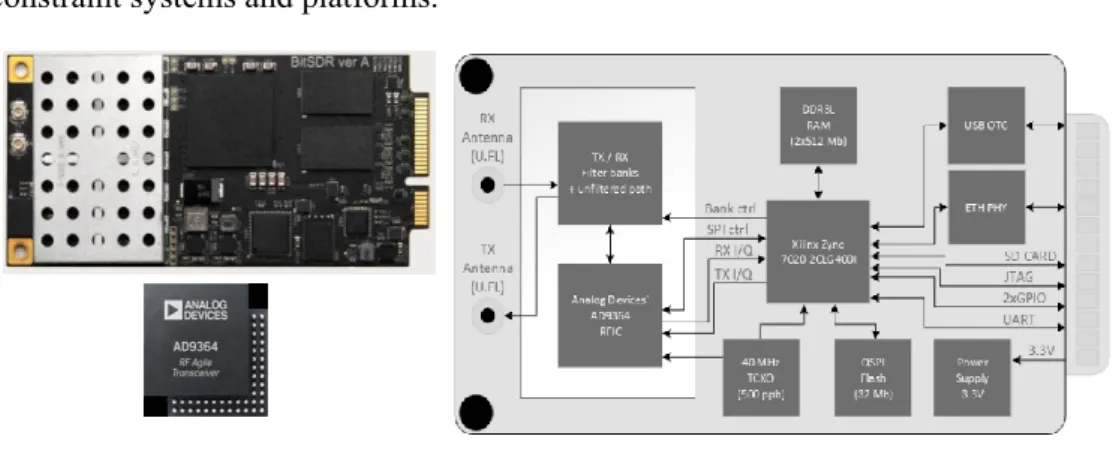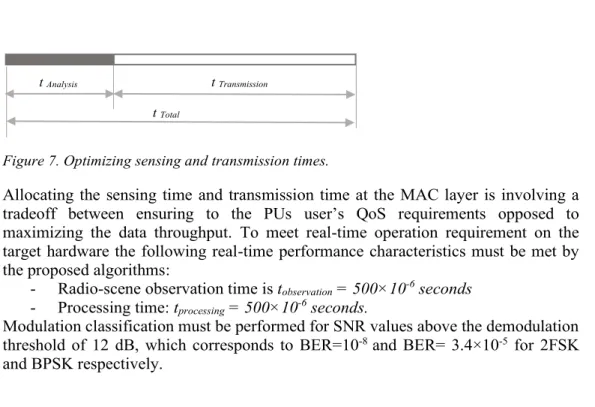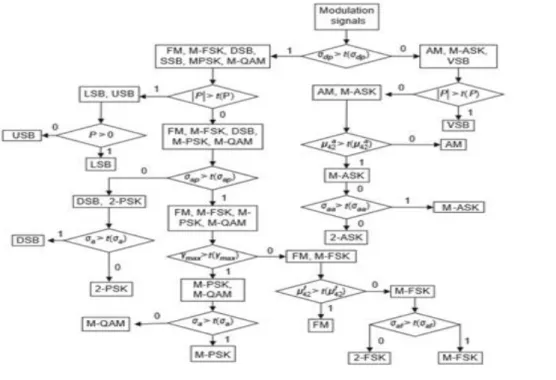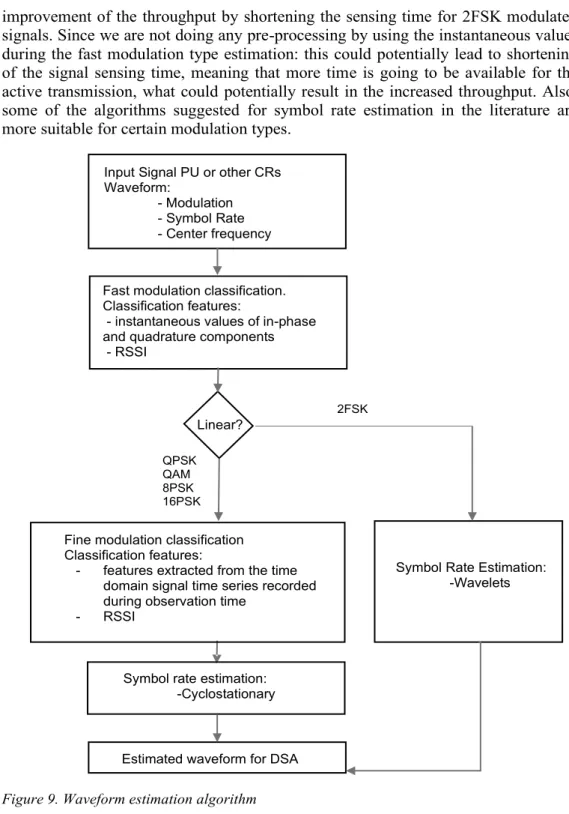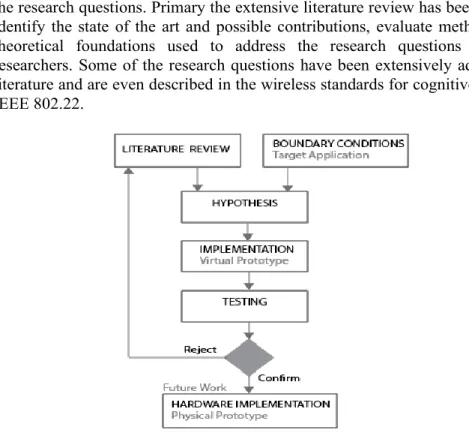Inna Valieva EN SIN G F O R D Y N A M IC S P EC TR U M A C C ES S I N C O G N IT IV E R A D IO
Mälardalen University Press Licentiate Theses No. 300
SPECTRUM SENSING FOR DYNAMIC
SPECTRUM ACCESS IN COGNITIVE RADIO
Inna Valieva 2020
School of Innovation, Design and Engineering
Mälardalen University Press Licentiate Theses No. 300
SPECTRUM SENSING FOR DYNAMIC
SPECTRUM ACCESS IN COGNITIVE RADIO
Inna Valieva 2020
Copyright © Inna Valieva, 2020 ISBN 978-91-7485-493-0
ISSN 1651-9256
Printed by E-Print AB, Stockholm, Sweden
Copyright © Inna Valieva, 2020 ISBN 978-91-7485-493-0
ISSN 1651-9256
spectrum allocation approach is leading to the spectrum scarcity problem when some of the licensed bands are heavily occupied and others are nearly unused. Spectrum sharing and opportunistic spectrum access allow achieving more efficient spectrum utilization. Radio scene analysis is a first step in the cognitive radio operation required to employ opportunistic spectrum access scenarios such as the dynamic spectrum access or frequency hopping spread spectrum. The objective of this work is to develop and virtual prototype the subset of radio scene analysis algorithms intended to be used for deployment of opportunistic spectrum access in our target application: a cognitive radio network consisting of multiple software-defined radio nodes BitSDR. The proposed radio scene analysis algorithms are devoted to solving two radio scene analysis problems: 1. detection of vacant frequency channels to implement spectrum sharing scenarios; 2. waveform estimation including modulation type, symbol rate, and central frequency estimation. From the subset of two radio scene analysis problems two hypotheses are formulated: the first is related to the vacant band identification and the second to waveform estimation. Then seven research questions related to the trade-off between the sensing accuracy and real-time operation requirement for the proposed radio scene analysis algorithms, the nature of the noise, and assumptions used to model the radio scene environment such as the AWGN channel.
In the scope of this work, Hypothesis 1, dedicated to vacant frequency bands detection, has been proven. Research questions related to the selection of the observation bandwidth, vacant channels detection threshold, and the optimal algorithm have been answered. We have proposed, prototyped and tested vacant frequency channels detection algorithm based on wavelet transform performing multichannel detection in the wide band of 56 MHz based on the received signal observed during 500 microseconds. Detection accuracy of 91 % has been demonstrated. Detection has been modeled as a binary hypothesis testing problem. The main advantage of using wavelets is the possibility of the results of wavelet transform to be applied for solving the waveform estimation problem including symbol rate and modulation type. Test data samples have been generated during the controlled experiment by the hardware signal generator and received by proprietary hardware based on AD9364 Analog Devices transceiver. To test Hypothesis 2 research questions related to the waveform estimation have been elaborated. The algorithm and features that have been chosen for modulation type classification have not met the required classification accuracy to classify between five studied modulation classes 2FSK, BPSK, QPSK, 8PSK, and 16PSK. Therefore, Hypothesis 2 has been rejected. To capture more of the fine differences between the received signal modulated into different linear modulations it has been suggested to use the spectral features derived from the time series signal observed during 500 microseconds or less observation time in the scope of the future work. However, the binary classification between 2FSK and BPSK presented in Paper 1 could be performed based on instantaneous values and SNR input: ensemble boosted trees and decision trees have shown an average classification accuracy of 86.3 % and 86.0 % respectively and classification speed of 1200000 objects per second, which is faster than required 2000 objects per second. The prototyping and testing of the proposed algorithm for symbol rate estimation based on deep learning have been performed to answer research question 2. Wavelet transform feature extraction has been proposed to be applied as a preprocessing step for deep learning-based estimation of the symbol rate for 2FSK modulated signals. This algorithm has shown an improvement in the accuracy of the symbol rate estimation in comparison with cyclostationary based detection. The validation accuracy of the symbol rate classification has reached 99.7 %. During testing, the highest average classification accuracy of 100 % has been observed for the signals with SNR levels 25-30 dB, while for signals with SNR 20-25 dB it was 96.3 %.
spectrum allocation approach is leading to the spectrum scarcity problem when some of the licensed bands are heavily occupied and others are nearly unused. Spectrum sharing and opportunistic spectrum access allow achieving more efficient spectrum utilization. Radio scene analysis is a first step in the cognitive radio operation required to employ opportunistic spectrum access scenarios such as the dynamic spectrum access or frequency hopping spread spectrum. The objective of this work is to develop and virtual prototype the subset of radio scene analysis algorithms intended to be used for deployment of opportunistic spectrum access in our target application: a cognitive radio network consisting of multiple software-defined radio nodes BitSDR. The proposed radio scene analysis algorithms are devoted to solving two radio scene analysis problems: 1. detection of vacant frequency channels to implement spectrum sharing scenarios; 2. waveform estimation including modulation type, symbol rate, and central frequency estimation. From the subset of two radio scene analysis problems two hypotheses are formulated: the first is related to the vacant band identification and the second to waveform estimation. Then seven research questions related to the trade-off between the sensing accuracy and real-time operation requirement for the proposed radio scene analysis algorithms, the nature of the noise, and assumptions used to model the radio scene environment such as the AWGN channel.
In the scope of this work, Hypothesis 1, dedicated to vacant frequency bands detection, has been proven. Research questions related to the selection of the observation bandwidth, vacant channels detection threshold, and the optimal algorithm have been answered. We have proposed, prototyped and tested vacant frequency channels detection algorithm based on wavelet transform performing multichannel detection in the wide band of 56 MHz based on the received signal observed during 500 microseconds. Detection accuracy of 91 % has been demonstrated. Detection has been modeled as a binary hypothesis testing problem. The main advantage of using wavelets is the possibility of the results of wavelet transform to be applied for solving the waveform estimation problem including symbol rate and modulation type. Test data samples have been generated during the controlled experiment by the hardware signal generator and received by proprietary hardware based on AD9364 Analog Devices transceiver. To test Hypothesis 2 research questions related to the waveform estimation have been elaborated. The algorithm and features that have been chosen for modulation type classification have not met the required classification accuracy to classify between five studied modulation classes 2FSK, BPSK, QPSK, 8PSK, and 16PSK. Therefore, Hypothesis 2 has been rejected. To capture more of the fine differences between the received signal modulated into different linear modulations it has been suggested to use the spectral features derived from the time series signal observed during 500 microseconds or less observation time in the scope of the future work. However, the binary classification between 2FSK and BPSK presented in Paper 1 could be performed based on instantaneous values and SNR input: ensemble boosted trees and decision trees have shown an average classification accuracy of 86.3 % and 86.0 % respectively and classification speed of 1200000 objects per second, which is faster than required 2000 objects per second. The prototyping and testing of the proposed algorithm for symbol rate estimation based on deep learning have been performed to answer research question 2. Wavelet transform feature extraction has been proposed to be applied as a preprocessing step for deep learning-based estimation of the symbol rate for 2FSK modulated signals. This algorithm has shown an improvement in the accuracy of the symbol rate estimation in comparison with cyclostationary based detection. The validation accuracy of the symbol rate classification has reached 99.7 %. During testing, the highest average classification accuracy of 100 % has been observed for the signals with SNR levels 25-30 dB, while for signals with SNR 20-25 dB it was 96.3 %.
spektrumallokering leder till problem med spektrumbrist när vissa av de licensierade banden är upptagna medan andra nästan är oanvända. Spektrumdelning och opportunistisk spektrumåtkomst möjliggör effektivare spektrumanvändning. Radio scene analys är ett första steg i den kognitiva radiooperationen som krävs för att använda opportunistiska spektrumåtkomstscenarier, såsom dynamisk spektrumåtkomst eller frekvenshoppande spridningsspektrum. Målet med detta arbete är att utveckla och göra en virtuell prototyp av undergruppen av radioscenanalysalgoritmer avsedda att användas för distribution av opportunistisk spektrumåtkomst i vår målapplikation: ett kognitivt radionätverk bestående av flera programvarudefinierade radionoder BitSDR. De föreslagna radioscenanalysalgoritmerna ägnas åt att lösa två radioscenanalysproblem: 1. detektering av lediga frekvenskanaler för att implementera spektrumdelningsscenarier; 2. vågformsuppskattning inklusive moduleringstyp, symbolhastighet och central frekvensuppskattning. Från delmängden av två radioscenanalysproblem formuleras två hypoteser: den första är relaterad till den lediga bandidentifieringen och den andra till vågformsuppskattning. Sedan sju forskningsfrågor relaterade till avvägningen mellan avkänningsnoggrannheten och realtidskravet för de föreslagna radioscene-analysalgoritmerna, brusets natur och antaganden som används för att modellera radioscenmiljön såsom AWGN-kanalen. Inom ramen för detta arbete har hypotes 1, tillägnad detektering av lediga frekvensband, bevisats. Forskningsfrågor relaterade till valet av observationsbandbredd, lediga kanaldetekteringsgränser och den optimala algoritmen har besvarats. Vi har föreslagit, prototyperat och testat lediga algoritmer för detektering av lediga frekvenskanaler baserat på wavelet-transform som utför flerkanalsdetektering i det breda bandet på 56 MHz baserat på den mottagna signalen som observerats under 500 mikrosekunder. Detektionsnoggrannhet på 91% har demonstrerats. Detektion har modellerats som ett problem med binär hypotesprovning. Den största fördelen med att använda vågkorn är möjligheten att resultaten av wavelet-transformering tillämpas för att lösa vågformsuppskattningsproblemet inklusive symbolhastighet och moduleringstyp. Testdataprov har genererats under det kontrollerade experimentet av hårdvarusignalgeneratorn och mottagits av egen hårdvara baserat på AD9364 Analog Devices-sändtagare. För att testa hypotes 2 har forskningsfrågor relaterade till vågformsberäkningen utvecklats. Algoritmen och funktionerna som har valts för klassificering av moduleringstyp har inte uppfyllt den nödvändiga klassificeringsnoggrannheten för att klassificera mellan fem studerade moduleringsklasserna 2FSK, BPSK, QPSK, 8PSK och 16PSK. Därför har hypotes 2 avvisats. För att fånga fler av de små skillnaderna mellan den mottagna signalen modulerad till olika linjära moduleringar har det föreslagits att använda de spektrala funktionerna som härrör från tidsserien som observerats under 500 mikrosekunder eller mindre observationstid inom ramen för det framtida arbetet. Den binära klassificeringen mellan 2FSK och BPSK som presenteras i artikel 1 kunde dock utföras baserat på momentana värden och SNR-ingång: ensemble-boostade träd och beslutsträd har visat en genomsnittlig klassificeringsnoggrannhet på 86,3% respektive 86,0% och klassningshastighet på 1200000 objekt per sekund, vilket är snabbare än kravet på 2000 objekt per sekund. Prototyperingen och testningen av den föreslagna algoritmen för symbolhastighetsuppskattning baserad på djupinlärning har utförts för att svara på forskningsfråga 2. Wavelet-transformeringsfunktionsextraktion har föreslagits tillämpas som ett förbehandlingssteg för djupinlärningsbaserad uppskattning av symbolhastigheten för 2FSK-modulerade signaler. Denna algoritm har visat en förbättring av noggrannheten för uppskattningen av symbolhastigheten i jämförelse med cyklostationbaserad detektion. Valideringsnoggrannheten för klassificeringen av symbolfrekvensen har nått 99,7%. Under test har den högsta genomsnittliga klassificeringsnoggrannheten på 100% observerats för signalerna med SNR-nivåer 25-30 dB, medan det för signaler med SNR 20-25 dB var 96,3%.
spektrumallokering leder till problem med spektrumbrist när vissa av de licensierade banden är upptagna medan andra nästan är oanvända. Spektrumdelning och opportunistisk spektrumåtkomst möjliggör effektivare spektrumanvändning. Radio scene analys är ett första steg i den kognitiva radiooperationen som krävs för att använda opportunistiska spektrumåtkomstscenarier, såsom dynamisk spektrumåtkomst eller frekvenshoppande spridningsspektrum. Målet med detta arbete är att utveckla och göra en virtuell prototyp av undergruppen av radioscenanalysalgoritmer avsedda att användas för distribution av opportunistisk spektrumåtkomst i vår målapplikation: ett kognitivt radionätverk bestående av flera programvarudefinierade radionoder BitSDR. De föreslagna radioscenanalysalgoritmerna ägnas åt att lösa två radioscenanalysproblem: 1. detektering av lediga frekvenskanaler för att implementera spektrumdelningsscenarier; 2. vågformsuppskattning inklusive moduleringstyp, symbolhastighet och central frekvensuppskattning. Från delmängden av två radioscenanalysproblem formuleras två hypoteser: den första är relaterad till den lediga bandidentifieringen och den andra till vågformsuppskattning. Sedan sju forskningsfrågor relaterade till avvägningen mellan avkänningsnoggrannheten och realtidskravet för de föreslagna radioscene-analysalgoritmerna, brusets natur och antaganden som används för att modellera radioscenmiljön såsom AWGN-kanalen. Inom ramen för detta arbete har hypotes 1, tillägnad detektering av lediga frekvensband, bevisats. Forskningsfrågor relaterade till valet av observationsbandbredd, lediga kanaldetekteringsgränser och den optimala algoritmen har besvarats. Vi har föreslagit, prototyperat och testat lediga algoritmer för detektering av lediga frekvenskanaler baserat på wavelet-transform som utför flerkanalsdetektering i det breda bandet på 56 MHz baserat på den mottagna signalen som observerats under 500 mikrosekunder. Detektionsnoggrannhet på 91% har demonstrerats. Detektion har modellerats som ett problem med binär hypotesprovning. Den största fördelen med att använda vågkorn är möjligheten att resultaten av wavelet-transformering tillämpas för att lösa vågformsuppskattningsproblemet inklusive symbolhastighet och moduleringstyp. Testdataprov har genererats under det kontrollerade experimentet av hårdvarusignalgeneratorn och mottagits av egen hårdvara baserat på AD9364 Analog Devices-sändtagare. För att testa hypotes 2 har forskningsfrågor relaterade till vågformsberäkningen utvecklats. Algoritmen och funktionerna som har valts för klassificering av moduleringstyp har inte uppfyllt den nödvändiga klassificeringsnoggrannheten för att klassificera mellan fem studerade moduleringsklasserna 2FSK, BPSK, QPSK, 8PSK och 16PSK. Därför har hypotes 2 avvisats. För att fånga fler av de små skillnaderna mellan den mottagna signalen modulerad till olika linjära moduleringar har det föreslagits att använda de spektrala funktionerna som härrör från tidsserien som observerats under 500 mikrosekunder eller mindre observationstid inom ramen för det framtida arbetet. Den binära klassificeringen mellan 2FSK och BPSK som presenteras i artikel 1 kunde dock utföras baserat på momentana värden och SNR-ingång: ensemble-boostade träd och beslutsträd har visat en genomsnittlig klassificeringsnoggrannhet på 86,3% respektive 86,0% och klassningshastighet på 1200000 objekt per sekund, vilket är snabbare än kravet på 2000 objekt per sekund. Prototyperingen och testningen av den föreslagna algoritmen för symbolhastighetsuppskattning baserad på djupinlärning har utförts för att svara på forskningsfråga 2. Wavelet-transformeringsfunktionsextraktion har föreslagits tillämpas som ett förbehandlingssteg för djupinlärningsbaserad uppskattning av symbolhastigheten för 2FSK-modulerade signaler. Denna algoritm har visat en förbättring av noggrannheten för uppskattningen av symbolhastigheten i jämförelse med cyklostationbaserad detektion. Valideringsnoggrannheten för klassificeringen av symbolfrekvensen har nått 99,7%. Under test har den högsta genomsnittliga klassificeringsnoggrannheten på 100% observerats för signalerna med SNR-nivåer 25-30 dB, medan det för signaler med SNR 20-25 dB var 96,3%.
Dedication
To my grandparents Evgenia and Hanis,
in loving memory
Dedication
To my grandparents Evgenia and Hanis,
List of Papers
This thesis is based on the following papers, which are referred to in the text by their Roman numerals.
1. Inna Valieva; Mats Björkman; Johan Åkerberg; Mikael Ekström; Iurii Voitenko. (2019) Multiple Machine Learning Algorithms Comparison for Modulation Type Classification for Efficient Cognitive Radio. MILCOM
2019 - 2019 IEEE Military Communications Conference (MILCOM).
2. Inna Valieva; Mats Björkman; Johan Åkerberg; Mikael Ekström; Iurii Voitenko. Blind Symbol Rate Estimation for Cognitive Radio Using Wavelet Transform and Deep Learning for FSK Modulated Digital Signals.
Manuscript
3. Inna Valieva; Mats Björkman; Johan Åkerberg; Mikael Ekström; Bharath Shashidhar; Iurii Voitenko. Autonomous Detection of Vacant Frequency Bands for Cognitive Radio. Manuscript.
Reprints were made with permission from the respective publishers.
List of Papers
This thesis is based on the following papers, which are referred to in the text by their Roman numerals.
1. Inna Valieva; Mats Björkman; Johan Åkerberg; Mikael Ekström; Iurii Voitenko. (2019) Multiple Machine Learning Algorithms Comparison for Modulation Type Classification for Efficient Cognitive Radio. MILCOM
2019 - 2019 IEEE Military Communications Conference (MILCOM).
2. Inna Valieva; Mats Björkman; Johan Åkerberg; Mikael Ekström; Iurii Voitenko. Blind Symbol Rate Estimation for Cognitive Radio Using Wavelet Transform and Deep Learning for FSK Modulated Digital Signals.
Manuscript
3. Inna Valieva; Mats Björkman; Johan Åkerberg; Mikael Ekström; Bharath Shashidhar; Iurii Voitenko. Autonomous Detection of Vacant Frequency Bands for Cognitive Radio. Manuscript.
Thesis Outline
This thesis consists of seven chapters.
Chapter 1 provides an introduction to the field and motivation for this work driven by the growing market of mobile devices and spectrum scarcity problem arising from the static spectrum allocation.
Chapter 2 provides the theoretical foundation and historic perspective to the software-defined radio and cognitive radio communication paradigms used in this work to answer the research questions and propose radio scene environment sensing algorithms contributing to efficient frequency spectrum utilization. Also, in this chapter our target application hardware: cognitive radio network is introduced. Also, the main challenges related to the radio scene analysis and its hardware implementation are discussed.
Chapter 3 provides an overview of the related work in the field carried out by other researchers. Algorithms applied for blind detection of vacant frequency channels such as matched filtering, waveform-based sensing, cyclostationarity-based sensing, energy detector-based sensing, wavelet transform, and AI-based algorithms are discussed in Chapter 3.1. Chapter 3.2 describes algorithms applied for waveform estimation including non-linear energy operator, inverse fast Fourier transform and baseband shape-based, maximum likelihood, wavelet transform and cyclostationary for symbol rate estimation and cyclostationary, maximum likelihood estimation, wavelets, AI-based algorithms for modulation type classification using various features extracted from the received signal.
In Chapter 4 the main research goals are defined. Primary, two hypotheses are formulated. The first is related to vacant band identification and the second to waveform estimation. To address the formulated hypotheses, eight research questions related to the tradeoff between the sensing accuracy and real-time operation requirement for the proposed radio scene analysis algorithms, the nature of the noise, and assumptions used to model the radio scene environment such as AWGN channel are formulated.
In Chapter 5 the research methodology used to answer the research questions and test the formulated hypothesis is described.
Thesis Outline
This thesis consists of seven chapters.
Chapter 1 provides an introduction to the field and motivation for this work driven by the growing market of mobile devices and spectrum scarcity problem arising from the static spectrum allocation.
Chapter 2 provides the theoretical foundation and historic perspective to the software-defined radio and cognitive radio communication paradigms used in this work to answer the research questions and propose radio scene environment sensing algorithms contributing to efficient frequency spectrum utilization. Also, in this chapter our target application hardware: cognitive radio network is introduced. Also, the main challenges related to the radio scene analysis and its hardware implementation are discussed.
Chapter 3 provides an overview of the related work in the field carried out by other researchers. Algorithms applied for blind detection of vacant frequency channels such as matched filtering, waveform-based sensing, cyclostationarity-based sensing, energy detector-based sensing, wavelet transform, and AI-based algorithms are discussed in Chapter 3.1. Chapter 3.2 describes algorithms applied for waveform estimation including non-linear energy operator, inverse fast Fourier transform and baseband shape-based, maximum likelihood, wavelet transform and cyclostationary for symbol rate estimation and cyclostationary, maximum likelihood estimation, wavelets, AI-based algorithms for modulation type classification using various features extracted from the received signal.
In Chapter 4 the main research goals are defined. Primary, two hypotheses are formulated. The first is related to vacant band identification and the second to waveform estimation. To address the formulated hypotheses, eight research questions related to the tradeoff between the sensing accuracy and real-time operation requirement for the proposed radio scene analysis algorithms, the nature of the noise, and assumptions used to model the radio scene environment such as AWGN channel are formulated.
In Chapter 5 the research methodology used to answer the research questions and test the formulated hypothesis is described.
Chapter 6 summarizes the main scientific contributions of this work including the study of the radio scene environment and nature of the noise, proposed radio scene analysis algorithms for vacant bands identification and waveform estimation. Chapter 6.2 provides the summary of the included papers and Chapter 6.3 discusses the relationship between the included papers and the research goals.
Chapter 7 provides the main conclusions and defines important research questions for future work.
Chapter 6 summarizes the main scientific contributions of this work including the study of the radio scene environment and nature of the noise, proposed radio scene analysis algorithms for vacant bands identification and waveform estimation. Chapter 6.2 provides the summary of the included papers and Chapter 6.3 discusses the relationship between the included papers and the research goals.
Chapter 7 provides the main conclusions and defines important research questions for future work.
Contents
List of Papers ... 5 Thesis Outline ... 6 Contents ... 8 Abbreviations... 9 1 Introduction ... 10 2 Background ... 142.1 SDR and Cognitive Radio ... 14
2.2 Spectrum Sensing and Radio-Scene Analysis. Challenges ... 17
2.3 Target Application Hardware ... 18
3 Related Work ... 21
3.1 Blind Detection of Vacant Frequency Bands ... 21
3.2 Waveform Estimation ... 23
3.2.1 Blind Symbol Rate Estimation ... 23
3.2.2 Modulation Type Classification ... 24
4 Research Goals ... 28 4.1 Hypothesis ... 28 4.2 Research Questions ... 31 5 Research Methodology ... 34 6 Thesis Contributions ... 36 6.1 Included Papers ... 36
6.2 Relationship Between Papers and Research Questions ... 36
6.3 Scientific Contributions ... 37
6.3.1 Contribution 1 ... 37
6.3.2 Contribution 2 ... 40
6.3.3 Contribution 3 ... 45
7 Conclusions and Future Work ... 55
References ... 57
Contents
List of Papers ... 5 Thesis Outline ... 6 Contents ... 8 Abbreviations... 9 1 Introduction ... 10 2 Background ... 142.1 SDR and Cognitive Radio ... 14
2.2 Spectrum Sensing and Radio-Scene Analysis. Challenges ... 17
2.3 Target Application Hardware ... 18
3 Related Work ... 21
3.1 Blind Detection of Vacant Frequency Bands ... 21
3.2 Waveform Estimation ... 23
3.2.1 Blind Symbol Rate Estimation ... 23
3.2.2 Modulation Type Classification ... 24
4 Research Goals ... 28 4.1 Hypothesis ... 28 4.2 Research Questions ... 31 5 Research Methodology ... 34 6 Thesis Contributions ... 36 6.1 Included Papers ... 36
6.2 Relationship Between Papers and Research Questions ... 36
6.3 Scientific Contributions ... 37
6.3.1 Contribution 1 ... 37
6.3.2 Contribution 2 ... 40
6.3.3 Contribution 3 ... 45
7 Conclusions and Future Work ... 55
Abbreviations
ADC Analog to digital converter AI Artificial intelligence
AWGN Additive white Gaussian noise BER Bit-error rate
BPSK Binary phase-shift keying CNN Convolutional neural network CR Cognitive radio
CWT Continuous wavelet transform DL Deep learning
DSA Dynamic spectrum access
DSSS Direct sequence spread spectrum FHSS Frequency hopping spread spectrum FSK Frequency-shift keying
MAC Media access control layer ML Machine learning
NET Network layer PHY Physical layer PU Primary user
QPSK Quadrature phase shift keying RSSI Received signal strength indicator SDR Software-defined radio
SOM Self-organizing maps SU Secondary user
SVM Support vector machine
Abbreviations
ADC Analog to digital converter AI Artificial intelligence
AWGN Additive white Gaussian noise BER Bit-error rate
BPSK Binary phase-shift keying CNN Convolutional neural network CR Cognitive radio
CWT Continuous wavelet transform DL Deep learning
DSA Dynamic spectrum access
DSSS Direct sequence spread spectrum FHSS Frequency hopping spread spectrum FSK Frequency-shift keying
MAC Media access control layer ML Machine learning
NET Network layer PHY Physical layer PU Primary user
QPSK Quadrature phase shift keying RSSI Received signal strength indicator SDR Software-defined radio
SOM Self-organizing maps SU Secondary user
1 Introduction
The global market of mobile devices and services actively using the electromagnetic spectrum is continuously growing. Global data traffic has shown an exponential growth from ten thousand petabytes per month in 2008 to a hundred and twenty thousand in 2018 (Bouwfonds, 2020). Already in 2014, the number of mobile devices has exceeded the Earth’s population (Boren, 2014) and keeps increasing. Advancements in digital electronics are successfully fulfilling this ever-increasing demand for processing power and mobile data capacity by keeping up with Moore’s law. Traditionally the utilization of the electromagnetic spectrum has been performed using a robust static approach developed almost a century ago. It rations access to the spectrum in exchange for the guarantee of interference-free communication: spectrum is divided into the rigid, exclusively licensed bands, allocated over large, geographically defined regions. In conditions when some of these license bands are being nearly unused, while the others are overwhelmed, the problem of spectrum scarcity arises (Rosker, 2020). To cope with the growing data traffic demand, the electromagnetic spectrum utilization policies have been reformed in recent years to allow the unlicensed secondary users to access licensed bands without causing interference to the licensed primary users (Xin, 2015).
Figure 1. Spectrum occupancy measurements in 6 GHz observation band (Cabri, 2007).
1 Introduction
The global market of mobile devices and services actively using the electromagnetic spectrum is continuously growing. Global data traffic has shown an exponential growth from ten thousand petabytes per month in 2008 to a hundred and twenty thousand in 2018 (Bouwfonds, 2020). Already in 2014, the number of mobile devices has exceeded the Earth’s population (Boren, 2014) and keeps increasing. Advancements in digital electronics are successfully fulfilling this ever-increasing demand for processing power and mobile data capacity by keeping up with Moore’s law. Traditionally the utilization of the electromagnetic spectrum has been performed using a robust static approach developed almost a century ago. It rations access to the spectrum in exchange for the guarantee of interference-free communication: spectrum is divided into the rigid, exclusively licensed bands, allocated over large, geographically defined regions. In conditions when some of these license bands are being nearly unused, while the others are overwhelmed, the problem of spectrum scarcity arises (Rosker, 2020). To cope with the growing data traffic demand, the electromagnetic spectrum utilization policies have been reformed in recent years to allow the unlicensed secondary users to access licensed bands without causing interference to the licensed primary users (Xin, 2015).
From the occupancy perspective, the spectrum is classified into three broad categories. Black spaces are spectrum bands occupied by high power local interferes. Gray spaces: are partly occupied by low power interferers (Haykin, 2005). However, they are still considered to be good candidates for spectrum reuse. Frequency bands assigned to a primary user but at a specific time and in a current geographic location not utilized by the primary user and free of the RF interferers, except for the ambient noise, are referred to as white spaces or spectrum holes (Varshney, 2017; Haykin, 2005). White spaces are obvious candidates for secondary reuse.
Practical spectrum measurements have provided some quantitative description of the spectrum underutilization and have shown great potential for its reuse. In the work of Awe (2015) the spectrum occupancy of 13 % was measured in New York and below 35 % in Washington for bands 30 MHz - 3 GHz. Figure 1 shows the spectrum utilization in the frequency range 0...6 GHz measured by the Berkeley Wireless Research Center at downtown Berkeley. For the frequency ranges 2 - 3 GHz and 5 - 6 GHz, the spectrum utilization is less than 10 %, while for 3 - 5 GHz, it is less than 1 % (Cabri, 2007). The study by Valenta (2010) of spectrum usage in European cities in the 400 MHz - 3 GHz band has shown also significant spectrum reuse opportunities: overall utilization of 6.5 % was observed in Northern suburb of Brno, Chech Republic; 10.7 % in Eastern suburb of Paris, France and 7.7 % in the city of Paris near the “Place la Nation”.
Spectrum scarcity has driven generations of wireless technology development (Varshney, 2017). SDR and cognitive radio are communication paradigms that are actively addressing the scarcity problem. Spectrum sharing and dynamic spectrum access are techniques used in CR to optimize the use of the electromagnetic spectrum. Spectrum sharing enables interference-free access to the same frequency bands between multiple users’ categories. The most common example of spectrum sharing in cognitive radio networks is the reuse of the TV white spaces: spectrum allocated to TV broadcasters for other wireless communications (Xin, 2015). The mutually exclusive access to the spectrum and absolute privilege of the PU results in arbitrary disruptions, unstable, and unpredictable performance for the secondary user. Dynamic spectrum access addresses the arbitrary disruptions of the secondary user and provides simultaneous access of the secondary users and primary users by sensing the vacant frequency channels and allowing devices to communicate in underused parts of the spectrum. Intelligent signal processing and decision-making are used to dynamically select spectrum band, time diversity, spatial diversity options, and generate a cognitive waveform (Rondeau, 2009). Waveform information of the active transmitting users including both: symbol rate and modulation type are necessary to employ an autonomous spectrum sharing scenario, i.e., to identify the spectrum reuse opportunities in conditions where no information about primary users and signals is available(Morozs, 2015).
From the occupancy perspective, the spectrum is classified into three broad categories. Black spaces are spectrum bands occupied by high power local interferes. Gray spaces: are partly occupied by low power interferers (Haykin, 2005). However, they are still considered to be good candidates for spectrum reuse. Frequency bands assigned to a primary user but at a specific time and in a current geographic location not utilized by the primary user and free of the RF interferers, except for the ambient noise, are referred to as white spaces or spectrum holes (Varshney, 2017; Haykin, 2005). White spaces are obvious candidates for secondary reuse.
Practical spectrum measurements have provided some quantitative description of the spectrum underutilization and have shown great potential for its reuse. In the work of Awe (2015) the spectrum occupancy of 13 % was measured in New York and below 35 % in Washington for bands 30 MHz - 3 GHz. Figure 1 shows the spectrum utilization in the frequency range 0...6 GHz measured by the Berkeley Wireless Research Center at downtown Berkeley. For the frequency ranges 2 - 3 GHz and 5 - 6 GHz, the spectrum utilization is less than 10 %, while for 3 - 5 GHz, it is less than 1 % (Cabri, 2007). The study by Valenta (2010) of spectrum usage in European cities in the 400 MHz - 3 GHz band has shown also significant spectrum reuse opportunities: overall utilization of 6.5 % was observed in Northern suburb of Brno, Chech Republic; 10.7 % in Eastern suburb of Paris, France and 7.7 % in the city of Paris near the “Place la Nation”.
Spectrum scarcity has driven generations of wireless technology development (Varshney, 2017). SDR and cognitive radio are communication paradigms that are actively addressing the scarcity problem. Spectrum sharing and dynamic spectrum access are techniques used in CR to optimize the use of the electromagnetic spectrum. Spectrum sharing enables interference-free access to the same frequency bands between multiple users’ categories. The most common example of spectrum sharing in cognitive radio networks is the reuse of the TV white spaces: spectrum allocated to TV broadcasters for other wireless communications (Xin, 2015). The mutually exclusive access to the spectrum and absolute privilege of the PU results in arbitrary disruptions, unstable, and unpredictable performance for the secondary user. Dynamic spectrum access addresses the arbitrary disruptions of the secondary user and provides simultaneous access of the secondary users and primary users by sensing the vacant frequency channels and allowing devices to communicate in underused parts of the spectrum. Intelligent signal processing and decision-making are used to dynamically select spectrum band, time diversity, spatial diversity options, and generate a cognitive waveform (Rondeau, 2009). Waveform information of the active transmitting users including both: symbol rate and modulation type are necessary to employ an autonomous spectrum sharing scenario, i.e., to identify the spectrum reuse opportunities in conditions where no information about primary users and signals is available(Morozs, 2015).
Figure 2 presents different DSA scenarios. In 2003 the Spectrum Policy Task Group of the FCC suggested (FCC, 2003b) the interference temperature concept for underlay spectrum sharing to allow low-power transmissions in licensed (used) bands. The FCC claims that often, between the original noise floor and the licensed signal of the incumbent radios, there lies an interval that could be exploited, which was identified as ‘new opportunities for spectrum use’ (FCC, 2003b).
Figure 2. DSA and reuse of vacant frequency channels: opportunistic spectrum usage with undelay spectrum (low power) and overlay spectrum sharing (high power, where vacant frequency channels exist in time and space) (Berlemann, 2009).
Nevertheless, having these bands available for reuse enables the immense economic success of wireless technologies like the popular WLAN IEEE 802.11. Opportunistic spectrum access to under-utilized spectrum, where cognitive radios use flexible spectrum access techniques for identifying under-utilized spectrum and avoiding harmful interference by for example using dynamic frequency selection, whether or not the frequency is assigned to licensed, primary services, is referred to as overlay spectrum sharing. Another spectrum sharing concept discussed in the literature and presented in Figure 2 above is vertical - horizontal sharing. The sharing of a licensed spectrum with primary radio systems is referred to as vertical sharing, and the sharing between radio systems with a similar regulatory priority (as in unlicensed bands) can be referred to as horizontal sharing(Berlemann, 2009).
The main challenges associated with the implementation of the dynamic spectrum access and spectrum sharing techniques are:
Control channel design: Reliable and dynamically changing control channels
algorithms are required to ensure control signaling between the two CR users on either end of the link uninterrupted by the neighboring PU activity. This messaging is used to exchange the sensing information and coordinate the channel access.
Figure 2 presents different DSA scenarios. In 2003 the Spectrum Policy Task Group of the FCC suggested (FCC, 2003b) the interference temperature concept for underlay spectrum sharing to allow low-power transmissions in licensed (used) bands. The FCC claims that often, between the original noise floor and the licensed signal of the incumbent radios, there lies an interval that could be exploited, which was identified as ‘new opportunities for spectrum use’ (FCC, 2003b).
Figure 2. DSA and reuse of vacant frequency channels: opportunistic spectrum usage with undelay spectrum (low power) and overlay spectrum sharing (high power, where vacant frequency channels exist in time and space) (Berlemann, 2009).
Nevertheless, having these bands available for reuse enables the immense economic success of wireless technologies like the popular WLAN IEEE 802.11. Opportunistic spectrum access to under-utilized spectrum, where cognitive radios use flexible spectrum access techniques for identifying under-utilized spectrum and avoiding harmful interference by for example using dynamic frequency selection, whether or not the frequency is assigned to licensed, primary services, is referred to as overlay spectrum sharing. Another spectrum sharing concept discussed in the literature and presented in Figure 2 above is vertical - horizontal sharing. The sharing of a licensed spectrum with primary radio systems is referred to as vertical sharing, and the sharing between radio systems with a similar regulatory priority (as in unlicensed bands) can be referred to as horizontal sharing(Berlemann, 2009).
The main challenges associated with the implementation of the dynamic spectrum access and spectrum sharing techniques are:
Control channel design: Reliable and dynamically changing control channels
algorithms are required to ensure control signaling between the two CR users on either end of the link uninterrupted by the neighboring PU activity. This messaging is used to exchange the sensing information and coordinate the channel access.
Radio scene analysis and adapting to PU transmission: Some PUs have specific
transmission patterns, such as pre-determined spectrum usage times and durations, such as television broadcast stations, or may have occasional random access to the channel, such as public service agencies. At these times, the CR MAC protocol may infer the nature of the PU and adapt its own transmission to avoid both interference to itself and prevent conflict with the PUs. For this reason, dynamic power control and transmission scheduling schemes need to be devised (Cormio, 2009). Also, the PUs transmission and waveform should be identified. Challenges related to radio scene analysis are discussed in Chapter 2 more in detail.
Radio scene analysis and adapting to PU transmission: Some PUs have specific
transmission patterns, such as pre-determined spectrum usage times and durations, such as television broadcast stations, or may have occasional random access to the channel, such as public service agencies. At these times, the CR MAC protocol may infer the nature of the PU and adapt its own transmission to avoid both interference to itself and prevent conflict with the PUs. For this reason, dynamic power control and transmission scheduling schemes need to be devised (Cormio, 2009). Also, the PUs transmission and waveform should be identified. Challenges related to radio scene analysis are discussed in Chapter 2 more in detail.
2 Background
This chapter provides the theoretical foundation and historic perspective to the software-defined radio and cognitive radio communication paradigms used in this work to approach the research problem of efficient frequency spectrum utilization. The main challenges related to radio scene analysis and its hardware implementation are discussed in Chapter 2.2.
2.1 SDR and Cognitive Radio
Software Defined Radio (SDR) is defined as “a class of reconfigurable/reprogrammable radios whose physical layer characteristics can be significantly modified via software changes” (Wyglinski, 2013). The term was first introduced in the 1970s by Joseph Mitola. The first demonstrated SDR prototype ICNIA was presented in 1988. It was a collection of several single-purpose radios in one box. However, the key milestone for the advancement of SDR technology took
Figure 3. Software Defined Radio (Wyglinski, 2013).
place in the early 1990s with SpeakEasy I/II research projects by the U.S. military (Wyglinski, 2013). It used a collection of programmable microprocessors for
2 Background
This chapter provides the theoretical foundation and historic perspective to the software-defined radio and cognitive radio communication paradigms used in this work to approach the research problem of efficient frequency spectrum utilization. The main challenges related to radio scene analysis and its hardware implementation are discussed in Chapter 2.2.
2.1 SDR and Cognitive Radio
Software Defined Radio (SDR) is defined as “a class of reconfigurable/reprogrammable radios whose physical layer characteristics can be significantly modified via software changes” (Wyglinski, 2013). The term was first introduced in the 1970s by Joseph Mitola. The first demonstrated SDR prototype ICNIA was presented in 1988. It was a collection of several single-purpose radios in one box. However, the key milestone for the advancement of SDR technology took
Figure 3. Software Defined Radio (Wyglinski, 2013).
place in the early 1990s with SpeakEasy I/II research projects by the U.S. military (Wyglinski, 2013). It used a collection of programmable microprocessors for
implementing more than 10 military communication standards, with transmission carrier frequencies ranging from 2 MHz to 2 GHz, which at that time was a major advancement in communication systems engineering.
Cognitive Radio is an SDR based communication systems paradigm that focuses on
employing highly agile, environmentally aware, intelligent wireless platforms to autonomously choose and fine-tune device operating parameters based on the prevailing radio and network environmental conditions (Wyglinski, 2013). The term “cognitive radio” was coined by Joseph Mitola in 1999 (Mitola and Maguire, 1999). In 2005, Simon Haykin had given a review of the cognitive radio concept and defined it as brain-empowered wireless communications (Abbas, 2015): “cognitive radio is an intelligent wireless communication system that is aware of its environment and uses the methodology of understanding by-building to learn from the environment and adapt to statistical variations in the input stimuli” (Haykin, 2005). Figure 4 presents three on-line cognitive tasks performed by cognitive radio. The first and second tasks are carried out in the receiver, and the third task is carried out in the transmitter (Haykin, 2005).
1. Radio-scene analysis, which encompasses: estimation of interference temperature of the radio environment and vacant frequency channels detection.
2. Channel identification, which encompasses the following: estimation of channel state information (CSI) and prediction of channel capacity for use by the transmitter.
3. Transmit-power control and dynamic spectrum management.
Figure 4. Basic cognitive cycle (Haykin, 2005).
These three cognitive tasks could be mapped into tree control actions: perception, conception and execution (Rondeau, 2009) illustrated in Figure 5.
During perception, sensors collect data on both external factors: channel conditions, other radios, regulations, user needs, and internal factors: waveform capabilities, available computational resources, remaining battery power. This control action is related to both tasks radio scene analysis and identification of the CR’s internal factors. During conception: an intelligent core combines knowledge from the sensing mechanism to aid the adaptation mechanism. This control action is related to channel, link budget estimation, and predictive modeling.
implementing more than 10 military communication standards, with transmission carrier frequencies ranging from 2 MHz to 2 GHz, which at that time was a major advancement in communication systems engineering.
Cognitive Radio is an SDR based communication systems paradigm that focuses on
employing highly agile, environmentally aware, intelligent wireless platforms to autonomously choose and fine-tune device operating parameters based on the prevailing radio and network environmental conditions (Wyglinski, 2013). The term “cognitive radio” was coined by Joseph Mitola in 1999 (Mitola and Maguire, 1999). In 2005, Simon Haykin had given a review of the cognitive radio concept and defined it as brain-empowered wireless communications (Abbas, 2015): “cognitive radio is an intelligent wireless communication system that is aware of its environment and uses the methodology of understanding by-building to learn from the environment and adapt to statistical variations in the input stimuli” (Haykin, 2005). Figure 4 presents three on-line cognitive tasks performed by cognitive radio. The first and second tasks are carried out in the receiver, and the third task is carried out in the transmitter (Haykin, 2005).
1. Radio-scene analysis, which encompasses: estimation of interference temperature of the radio environment and vacant frequency channels detection.
2. Channel identification, which encompasses the following: estimation of channel state information (CSI) and prediction of channel capacity for use by the transmitter.
3. Transmit-power control and dynamic spectrum management.
Figure 4. Basic cognitive cycle (Haykin, 2005).
These three cognitive tasks could be mapped into tree control actions: perception, conception and execution (Rondeau, 2009) illustrated in Figure 5.
During perception, sensors collect data on both external factors: channel conditions, other radios, regulations, user needs, and internal factors: waveform capabilities, available computational resources, remaining battery power. This control action is related to both tasks radio scene analysis and identification of the CR’s internal factors. During conception: an intelligent core combines knowledge from the sensing mechanism to aid the adaptation mechanism. This control action is related to channel, link budget estimation, and predictive modeling.
Execution control action employs an optimization and adaptation mechanism that adjusts the radio’s behavior towards the environment and user-defined parameters. This control action is related to the tasks of dynamic frequency management and power control.
Figure 5.Cognitive radio: control actions.
Nowadays SDR and cognitive radio technologies are successfully making their way into modern wireless standards. Modern mobile phones have multiple cognitive radio features such as support of multiple waveforms, frequency bands, the ability to transmit various types of data including voice traffic, text messages, and data. They are also equipped with multiple communication standards such as Bluetooth and WiFi and have adaptive power control and modulation adaptation in response to signal quality. In 2009 IEEE 802.22 wireless regional area networks, WRAN has been introduced, and using white spaces in the television frequency spectrum
Table 1. Cognitive Radio Example of Operation Parameters and Optimization objectives.
Device Configurations: Knobs, (Layer)
Performance and Environment: Meters,
(Layer)
Target networking experience: Optimization objectives,
(Layer)
Packet size (NET) Packet rate (NET) Channel coding
rate, type (MAC) Frame size, type (MAC) Duplexing (MAC) Encryption (MAC) Transmitter power (PHY) Modulation type (PHY) Modulation index (PHY) Carrier frequency (PHY) Bandwidth (PHY) Symbol rate (PHY)
Packet delay (NET) Packet jitter (NET) Data rate (MAC) Signal power (PHY) Noise Power (PHY) Delay spread (PHY) Multipath profile (PHY) Power consumption (PHY) Fading statistics (PHY) Spectral efficiency (PHY) Path loss (PHY) BER (PHY)
Minimize delay (NET) Maximize throughput (MAC) Minimize bit error rate (PHY) Minimize power
consumption (PHY) Minimize interference (PHY) Maximize spectral
efficiency (PHY)
EXECUTION
PERCEPTION CONCEPTION
Execution control action employs an optimization and adaptation mechanism that adjusts the radio’s behavior towards the environment and user-defined parameters. This control action is related to the tasks of dynamic frequency management and power control.
Figure 5.Cognitive radio: control actions.
Nowadays SDR and cognitive radio technologies are successfully making their way into modern wireless standards. Modern mobile phones have multiple cognitive radio features such as support of multiple waveforms, frequency bands, the ability to transmit various types of data including voice traffic, text messages, and data. They are also equipped with multiple communication standards such as Bluetooth and WiFi and have adaptive power control and modulation adaptation in response to signal quality. In 2009 IEEE 802.22 wireless regional area networks, WRAN has been introduced, and using white spaces in the television frequency spectrum
Table 1. Cognitive Radio Example of Operation Parameters and Optimization objectives.
Device Configurations: Knobs, (Layer)
Performance and Environment: Meters,
(Layer)
Target networking experience: Optimization objectives,
(Layer)
Packet size (NET) Packet rate (NET) Channel coding
rate, type (MAC) Frame size, type (MAC) Duplexing (MAC) Encryption (MAC) Transmitter power (PHY) Modulation type (PHY) Modulation index (PHY) Carrier frequency (PHY) Bandwidth (PHY) Symbol rate (PHY)
Packet delay (NET) Packet jitter (NET) Data rate (MAC) Signal power (PHY) Noise Power (PHY) Delay spread (PHY) Multipath profile (PHY) Power consumption (PHY) Fading statistics (PHY) Spectral efficiency (PHY) Path loss (PHY) BER (PHY)
Minimize delay (NET) Maximize throughput (MAC) Minimize bit error rate (PHY) Minimize power
consumption (PHY) Minimize interference (PHY) Maximize spectral
efficiency (PHY)
EXECUTION
became the first full standard regulating cognitive radio functionality on MAC and PHY for deploying the dynamic spectrum access (IEEE, 2009; Giorgetti, 2012).
The operational parameters in cognitive radio are traditionally described in terms of knobs and meters. This terminology comes from conventional radio terminology. Knobs are defined as parameters affecting the link performance and radio operation. Some of them are assumed to be the design parameters setting the device configuration and some of them are remaining under real-time control. On the other hand, meters describe the system performance and network environment (Bates, 2006). Knobs are configured to reach target network experience in current network conditions. Target networking experience is usually defined in terms of optimization objective, for example: minimize bit error rate or maximize data throughput. To achieve the substantial level of real-time cognitive decision-making AI algorithms are used for perception in radio scene analysis, conception for channel estimation, and during execution in the cognitive controller. The focus of this work has been narrowed down to the perception task and, mainly, on the radio-scene analysis, specifically on detection of the vacant frequency channels, since it is the very first step in cognitive radio operation, defining one of the most critical operation parameters: the frequency channel transmitter and receiver agree to operate in. This work also covers some aspects of the blind waveform estimation of the received signal or PU. Some PUs has specific transmission patterns or may have occasional random access to the channel. The CR MAC protocol may infer the nature of the PU and adapt dynamically its own transmission to avoid both interference to itself and causing harmful interference to PU.
2.2 Spectrum Sensing and Radio-Scene Analysis. Challenges
The main challenges associated with perception control action and radio scene analysis cognitive tasks summarized by Ahmed (2010):
• Hardware Requirements. Software-defined radio-based hardware platform containing the analog to digital converters (ADCs) with high-speed signal processors, high resolution, and dynamic frequency operation range is required for accomplishing the spectrum sensing task fast enough to guarantee required QoS in cognitive radio networks (Arslan, 2007). Our target application and its operational characteristics, as well as the real-time operation requirements, are presented in Chapter 2.3 of this work.
• The Hidden Primary User Problem (Ganesan, 2005). It is caused by multiple factors like shadowing, severe multipath fading observed by the secondary user during the transmission scanning for the primary user: if one PU is “hidden” to a SU during the transmission/reception, some data can be lost when the appearance of the PU is not identified by one of the two SUs. This is particularly serious when the PU affects the receiving side: the receiver could not receive on a channel due to the PU interference while the transmitter continues to send data.
became the first full standard regulating cognitive radio functionality on MAC and PHY for deploying the dynamic spectrum access (IEEE, 2009; Giorgetti, 2012).
The operational parameters in cognitive radio are traditionally described in terms of knobs and meters. This terminology comes from conventional radio terminology. Knobs are defined as parameters affecting the link performance and radio operation. Some of them are assumed to be the design parameters setting the device configuration and some of them are remaining under real-time control. On the other hand, meters describe the system performance and network environment (Bates, 2006). Knobs are configured to reach target network experience in current network conditions. Target networking experience is usually defined in terms of optimization objective, for example: minimize bit error rate or maximize data throughput. To achieve the substantial level of real-time cognitive decision-making AI algorithms are used for perception in radio scene analysis, conception for channel estimation, and during execution in the cognitive controller. The focus of this work has been narrowed down to the perception task and, mainly, on the radio-scene analysis, specifically on detection of the vacant frequency channels, since it is the very first step in cognitive radio operation, defining one of the most critical operation parameters: the frequency channel transmitter and receiver agree to operate in. This work also covers some aspects of the blind waveform estimation of the received signal or PU. Some PUs has specific transmission patterns or may have occasional random access to the channel. The CR MAC protocol may infer the nature of the PU and adapt dynamically its own transmission to avoid both interference to itself and causing harmful interference to PU.
2.2 Spectrum Sensing and Radio-Scene Analysis. Challenges
The main challenges associated with perception control action and radio scene analysis cognitive tasks summarized by Ahmed (2010):
• Hardware Requirements. Software-defined radio-based hardware platform containing the analog to digital converters (ADCs) with high-speed signal processors, high resolution, and dynamic frequency operation range is required for accomplishing the spectrum sensing task fast enough to guarantee required QoS in cognitive radio networks (Arslan, 2007). Our target application and its operational characteristics, as well as the real-time operation requirements, are presented in Chapter 2.3 of this work.
• The Hidden Primary User Problem (Ganesan, 2005). It is caused by multiple factors like shadowing, severe multipath fading observed by the secondary user during the transmission scanning for the primary user: if one PU is “hidden” to a SU during the transmission/reception, some data can be lost when the appearance of the PU is not identified by one of the two SUs. This is particularly serious when the PU affects the receiving side: the receiver could not receive on a channel due to the PU interference while the transmitter continues to send data.
• Spread Spectrum Primary Users are the primary users (PUs) using spread spectrum signaling that are hard to identify as the power of the PUs is dispersed over a broad frequency range, while the real information bandwidth is significantly narrower (Cabric, 2004). The spread spectrum has two further types of technologies: frequency hopping spread spectrum (FHSS) and direct sequence spread spectrum (DSSS). FHSS devices adjust their operational frequencies vigorously to multiple narrowband channels. This is called hopping and is performed according to a sequence recognized by both the transmitter and the receiver. DSSS devices resemble the FHSS devices but they utilize a single frequency band or channel to spread their energy. An example of fixed frequency devices is IEEE 802.11a/g. Our target application cognitive radio has FHSS capabilities, operating in frequency range with a maximum possible instantaneous bandwidth of 56 MHz limited by optimal receiver sensitivity.
• Sensing Time and Frequency. The sensing frequency: how often sensing should be performed by the cognitive radio, and sensing time: the duration the sensing is performed are key parameters that should be chosen carefully. Sensing frequency requirements can be relaxed in case the status of the PU is known and changes slowly. For example, the sensing period for IEEE 802.22 standard is 30 seconds. While higher sensing times ensure the correct detection of the spectrum, this may result in a comparatively smaller duration for actual data transmission during the total time for which the spectrum may be used, thereby lowering the throughput. (Cormio, 2009). To achieve the optimum between sensing time and throughput in IEEE 802.22 has a two-stage sensing (TSS) mechanism that includes: fast sensing, done at the rate of 1 ms/channel, and fine sensing performed on-demand. The challenges related to sensing time are discussed in detail in Chapter 4 dedicated to the research goals.
2.3 Target Application Hardware
This chapter provides the brief introduction to our target application: cognitive radio network hardware, its operational characteristics and boundary conditions it applies to the proposed radio scene analysis algorithms to fulfill the real-time operation requirement.
Our target application is a software-defined radio-based network consisting of the digital radio nodes. SDR based nodes operating in the frequency band from 70 MHz to 6 GHz with up to 56 MHz of instantaneous bandwidth are used as the hardware platform for the cognitive functionality deployment with FHSS capabilities. Figure 6 below presents our target hardware, its principal schematics and a photo of transceiver AD 9364. Available computational resources are: Dual-core ARM Cortex A9 CPU, 2x512 MB of DDR3L RAM and 32 MB of QSPI flash memory. Operation system is Embedded Linux. The radio part is based on Analog Devices AD 9364 radio transceiver and Xilinx' Zynq-7020 FPGA. Operational
• Spread Spectrum Primary Users are the primary users (PUs) using spread spectrum signaling that are hard to identify as the power of the PUs is dispersed over a broad frequency range, while the real information bandwidth is significantly narrower (Cabric, 2004). The spread spectrum has two further types of technologies: frequency hopping spread spectrum (FHSS) and direct sequence spread spectrum (DSSS). FHSS devices adjust their operational frequencies vigorously to multiple narrowband channels. This is called hopping and is performed according to a sequence recognized by both the transmitter and the receiver. DSSS devices resemble the FHSS devices but they utilize a single frequency band or channel to spread their energy. An example of fixed frequency devices is IEEE 802.11a/g. Our target application cognitive radio has FHSS capabilities, operating in frequency range with a maximum possible instantaneous bandwidth of 56 MHz limited by optimal receiver sensitivity.
• Sensing Time and Frequency. The sensing frequency: how often sensing should be performed by the cognitive radio, and sensing time: the duration the sensing is performed are key parameters that should be chosen carefully. Sensing frequency requirements can be relaxed in case the status of the PU is known and changes slowly. For example, the sensing period for IEEE 802.22 standard is 30 seconds. While higher sensing times ensure the correct detection of the spectrum, this may result in a comparatively smaller duration for actual data transmission during the total time for which the spectrum may be used, thereby lowering the throughput. (Cormio, 2009). To achieve the optimum between sensing time and throughput in IEEE 802.22 has a two-stage sensing (TSS) mechanism that includes: fast sensing, done at the rate of 1 ms/channel, and fine sensing performed on-demand. The challenges related to sensing time are discussed in detail in Chapter 4 dedicated to the research goals.
2.3 Target Application Hardware
This chapter provides the brief introduction to our target application: cognitive radio network hardware, its operational characteristics and boundary conditions it applies to the proposed radio scene analysis algorithms to fulfill the real-time operation requirement.
Our target application is a software-defined radio-based network consisting of the digital radio nodes. SDR based nodes operating in the frequency band from 70 MHz to 6 GHz with up to 56 MHz of instantaneous bandwidth are used as the hardware platform for the cognitive functionality deployment with FHSS capabilities. Figure 6 below presents our target hardware, its principal schematics and a photo of transceiver AD 9364. Available computational resources are: Dual-core ARM Cortex A9 CPU, 2x512 MB of DDR3L RAM and 32 MB of QSPI flash memory. Operation system is Embedded Linux. The radio part is based on Analog Devices AD 9364 radio transceiver and Xilinx' Zynq-7020 FPGA. Operational
characteristics of AD 9364 are summarized in Table 2. It is optimized for a small size, light weight, and low power consumption allowing integration into power constraint systems and platforms.
Figure 6. Target application hardware, schematics and radio transceiver AD9364.
It is supporting multiple digital modulations including both linear: QPSK, BPSK, QAM, PSK and non-linear: FSK. Symbol rate could be also adjusted to generate cognitive waveform. In this work only three symbol rates have been studied: 10, 100 and 1000 KSymbol/second. Our target application predefines most of the boundary conditions and operational requirements such as required decision-making speed and computational resources available. In this work time required for radio scene analysis
tAnalysis is defined as a sum of time required for radio scene observation tObservation and
processing tProcessing of the observed signal on the receiver front end. Time allocated
for the active data transmission is data transmission time, tTransmission and total time is
the sum of observation and transmission time as illustrated on Figure 7.
Table 2. AD9364 Operational Characteristics (Analog Devices, 2013).
TX band: 47 MHz to 6.0 GHz
RX band: 70 MHz to 6.0 GHz
DACs and ADCs 12-bit, RF 2 × 2 transceiver integrated
Tunable channel bandwidth: <200 kHz to 56 MHz
Dual receivers 6 differential or 12 single-ended inputs
Receiver sensitivity noise figure 2 dB at 800 MHz LO
RX gain control Real-time monitor and control signals for manual gain
Independent automatic gain control
Dual transmitters: 4 differential outputs
Highly linear broadband
transmitter TX EVM: ≤−40 Db TX noise: ≤−157 dBm/Hz noise floor
TX monitor: ≥66 dB dynamic range with 1 dB accuracy
local oscillator (LO) step size 2.4 Hz maximum
characteristics of AD 9364 are summarized in Table 2. It is optimized for a small size, light weight, and low power consumption allowing integration into power constraint systems and platforms.
Figure 6. Target application hardware, schematics and radio transceiver AD9364.
It is supporting multiple digital modulations including both linear: QPSK, BPSK, QAM, PSK and non-linear: FSK. Symbol rate could be also adjusted to generate cognitive waveform. In this work only three symbol rates have been studied: 10, 100 and 1000 KSymbol/second. Our target application predefines most of the boundary conditions and operational requirements such as required decision-making speed and computational resources available. In this work time required for radio scene analysis
tAnalysis is defined as a sum of time required for radio scene observation tObservation and
processing tProcessing of the observed signal on the receiver front end. Time allocated
for the active data transmission is data transmission time, tTransmission and total time is
the sum of observation and transmission time as illustrated on Figure 7.
Table 2. AD9364 Operational Characteristics (Analog Devices, 2013).
TX band: 47 MHz to 6.0 GHz
RX band: 70 MHz to 6.0 GHz
DACs and ADCs 12-bit, RF 2 × 2 transceiver integrated
Tunable channel bandwidth: <200 kHz to 56 MHz
Dual receivers 6 differential or 12 single-ended inputs
Receiver sensitivity noise figure 2 dB at 800 MHz LO
RX gain control Real-time monitor and control signals for manual gain
Independent automatic gain control
Dual transmitters: 4 differential outputs
Highly linear broadband
transmitter TX EVM: ≤−40 Db TX noise: ≤−157 dBm/Hz noise floor
TX monitor: ≥66 dB dynamic range with 1 dB accuracy
